The coast of Orange County is perhaps one of the best locations on earth for whale and dolphin watching due to the rich biodiversity, productive feeding grounds, and the opportunity to see wildlife year-round! Throughout the year Orange County has five whale species and four species of dolphins commonly seen off the coast, with many other rare visitors sighted every few years.

Common Sightings in Orange County
Whales
Blue whales (Summer/Fall)

Seeing a blue whale is an experience on many people’s bucket list because they are the largest animals that have ever lived on planet earth, even bigger than any dinosaur! These giants are named for the mottled blue/gray coloration of their skin and the turquoise glow they create as they move just under the surface of the water. Averaging around 80 feet long, they can stretch to over 100 feet – as long as three school buses in a row! Weighing as much as 40 elephants, they must eat a TON to maintain their massive body size (three tons to be exact!) Every day they must consume nearly 6000 pounds of food, which is approximately how much food an average human would eat in three years!
One of the most amazing things is that the largest animals in the world feed almost exclusively on some of the smallest – krill! Tiny shrimplike animals, krill are each only about an inch long. Underwater, krill form large patches, and a single blue whale can wipe out over 40 million of them in one day! Belonging to a category called “baleen whales,” blue whales lack teeth. Instead, they have plates made of keratin (same as our fingernails and hair) that hang from their upper jaw and resemble bristles on the end of a broom. Baleen plates are used for filtering out small creatures from the ocean. Their expandable throat groves allow them to gulp huge volumes of water, which they push back out through the bristly baleen, trapping their prey inside like a giant spaghetti strainer. Don’t be worried about being swallowed by a blue whale though; despite their enormous size, their throats are no bigger than a beach ball!
Humpback whales (Summer/Fall)

Humpback whales are easily the most charismatic and recognizable whales around the world! Known for their breaching behavior and friendly nature, humpbacks are a favorite of whale watchers off the coast of Orange County. Named for the deep arch of their backs when they dive, humpback whales are the acrobats of the ocean – they are frequently seen performing impressive surface behaviors like bringing their big, beautiful tails out of the water, slapping their tails and pectoral fins on the surface, lunge feeding, and even breaching, which is when they leap spectacularly out of the water.
Humpback whales can reach between 40-50 feet in length and their long pectoral fins can grow to be nearly 1/3 of their total body size. Though they can be seen at any time throughout the year, they are most commonly encountered between April and November. They spend their summers off the coast of California feeding on small schooling fish like sardines and anchovies, along with krill. In the winter they migrate to the warm waters in Mexico near the Sea of Cortez where they mate and give birth to calves. Humpbacks are well studied because of the recognizable patterns on the underside of their tails. Every whale tail is unique and has individual markings and colorations which allow researchers and whale watchers to photo-identify the whales to learn about their migration patterns and social behavior.
Gray whales (Winter/Spring)

Every year from December to May, visitors of Orange County have the opportunity to witness upwards of 25,000 gray whales as they pass our coast on their annual migration from their feeding grounds in Alaska, where they spend the summer months, to their breeding grounds in Mexico. They spend the wintertime mating, giving birth, and raising their calves in shallow lagoons before heading north to feed in the Bering and Chukchi Seas. Gray whales are champion migrators and undergo the longest migration of any mammal on Earth – their yearly journey equates to nearly 12,000 miles round trip. In one lifetime, a gray whale could swim from here to the moon and back two and a half times!
Adult gray whales reach lengths between 40-50 feet long, about the size of a school bus. They are identified by their mottled gray and white coloration, their lack of a dorsal fin, and their heart shaped spout. They are a slow-moving species and can acquire hundreds of pounds of hitchhikers like barnacles and whale lice. Gray whales are coastal swimmers and can often be found just off the beach – sometimes in less than 10 feet of water! Lucky beachgoers sometimes get to witness gray whales rolling around in the sand or spy hopping, which is when they bring their heads up out of the water to take a look around. Gray whales use their baleen plates to filter out small creatures from the muddy sea floor, such as crustaceans, shrimp, worms, and amphipods.
Fin whales (Year-round)
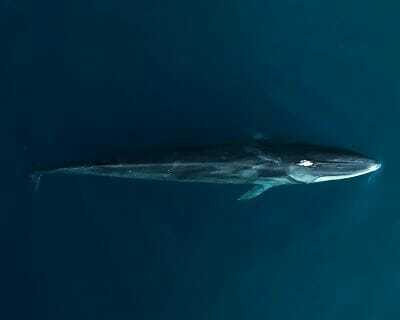
The sleek and impressive fin whale is the second largest whale on earth, just behind its cousin the blue whale. Measuring between 70 and 80 feet long, these baleen whales can be seen anytime throughout the year off the coast of Orange County, as long as there is a sufficient supply of krill and small schooling fish to support their huge appetite! Fin whales have a unique appearance, making them easy to identify at sea. Their bodies are long, slender, and streamlined and generally dark grey in color, though fin whales have a unique asymmetrical coloration on their lower jaw. The left side matches the rest of its gray body, but the right side of their jaw is stunningly white. While its unknown exactly why they have this one-of-a-kind coloration, it is believed to aid in feeding. Further down their back, the dark gray blends into a lighter gray chevron pattern, leading to their hook-like dorsal fin located about 2/3 of the way down their body. The underside of the whale’s tail is white in color, but fin whales rarely bring their tail out of the water or breach the surface like their acrobatic humpback whale cousins.
Fin whales are nicknamed “greyhounds of the sea” because they are the fastest moving whale, capable of traveling 30mph in short bursts. Because of their notoriously allusive nature, fin whale migration patterns are difficult to study but they can be seen moving through our waters any time of the year. In the past, fin whales have become curious and friendly with whale watching boats, giving passengers memories of a lifetime!
Minke whales (Year-round)
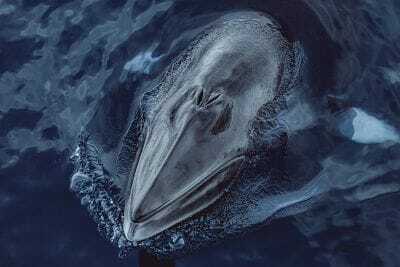
Pronounced ‘mink-ee,’ these whales are the smallest and the most abundant whales found off the coast of Orange County. Growing to lengths up to 30 feet, minke whales are still an incredibly large animal but small in comparison to their larger whale cousins. These whales are gray in color with a pointed triangular-shaped rostrum (snout) that often lifts out of the water when taking a breath. Further down their back is a large curved dorsal fin which can be seen slicing through the surface of the water. Their pectoral fins have characteristic white bands that set them apart from other whale species. Minke whales are one of the smallest baleen whales, feeding on krill, small schooling fish, and plankton.
Minke whales are sometimes nicknamed “stinky, slinky minkes” because of the pungent smell of minke whale breath and their stealthy behavior. Unlike many other species of whales, minke whales do not produce a spout when they surface to breath. Instead, they are spotted by their dorsal fin moving through the water. Minke whales seem to have an affinity for small boats and have often been seen “mugging” Newport Coastal Adventure’s zodiacs.
Dolphins
Common dolphins (Year-round)
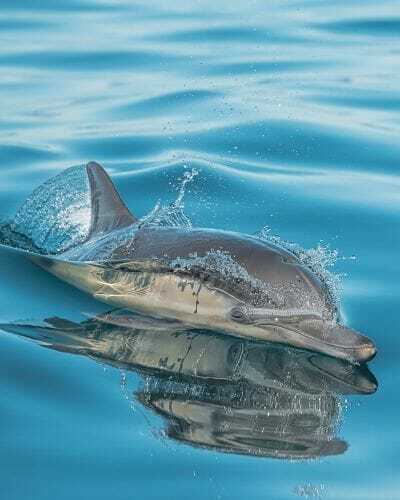
Common dolphins are the most abundant flippered friends that we encounter off Laguna Beach with over 400,000 dolphins found off the Southern California coastline. We often see them in large groups and a typical pod will number around 200 individuals, though sometimes we see them by the thousands! Common dolphins average between 6-9 feet long and weigh between 200-300 pounds and have intricate coloration patterns and range from white/yellow to gray/black. They feed on small schooling fish like sardines and anchovies, as well as squid. Common dolphins are extremely friendly and social and will frequently come right over to the boat to bow ride and surf in the boat wake. They are hugely acrobatic and sometimes will suddenly launch out of the water in a spectacular leap, landing with a big splash.
Bottlenose dolphins (Year-round)

Right off the coast of Orange County we have the opportunity to experience one of the most intelligent creatures on earth – the bottlenose dolphin! One of the most famous and recognizable species of dolphin, bottlenose are beloved by beachgoers and boaters around the world due to their playful and social nature, their acrobatic behavior, and their seemingly permanent smile! Adult bottlenose dolphins grow between 10-12 feet in length and can weigh over 1200 lbs. Their diet consists of fish and squid. Bottlenose dolphins can effortlessly leap 15+ feet out of the water, much to the thrill of whale and dolphin watchers!
Risso’s dolphins (Year-round)

The largest dolphins commonly seen off the coast, Risso’s dolphins are unique and awe-inspiring in many ways! Born dark gray, Risso’s dolphins lighten up as they age due to the characteristic scratches they receive from the teeth of other members of their pod as a social behavior, along with scarring from the beaks and tentacles of squid, their main food source. They grow between 8-13 feet in length and can dive over 30 minutes! Risso’s dolphins are rarer than their common dolphin cousins but can still be seen nearly every month off Orange County.
Pacific White-Sided dolphins (Winter/Spring)

One of our winter visitors, we usually see Pacific White-Sided dolphins throughout the months of December-March. They prefer colder water and can be seen all the way up the Pacific coast to Alaska. They are one of our smallest dolphin species with a distinct appearance. They have unique black and white coloration patterns with light gray stripes along their sides, sometimes called their “suspenders.” They have a large curved dorsal fin, and they can be seen in pods anywhere from 10 to 1000 animals at a time. They are an extremely playful and social species and can often be seen bow riding and surfing the boat wake, along with jumping and somersaulting out of the water.
Pinnipeds
Seals/Sea Lions (Year-round)

Orange County is a prime location for spotting pinnipeds, or flipper footed marine mammals including California Sea Lions, Harbor Seals, and Elephant Seals. While similar, seals and sea lions differ in many ways, although it is quite common to mix up these animals. However, there are a few simple ways to tell them apart: look at the flippers and the ears. California sea lions are a tan to chocolatey brown color and have long front flippers that enable them to jump much higher out of the water. They also have flexible pelvis bones which allow them to rotate their flippers to use as legs so they can walk around out of water.

Harbor seals range from brown to gray with characteristic white spots and have much shorter front flippers. Their short flippers do not allow them to walk out of water and instead they ungulate, or inchworm around on their bellies while on land. When it comes to ears, sea lions have visible small external ear flaps, while seals only have small holes on the sides of their heads where their ear openings are located. California sea lions are larger with males reaching up to 800 lbs. Harbor seals grow to 300 lbs. fully grown. Elephant seals can also be spotted resting out at sea – look quickly though; when they disappear, they’ll be under water for up to 45 minutes! Fully grown, elephant seals are behemoths reaching up to 8000 lbs!
Rare Visitors in Orange County
Sei whales & Bryde’s whales
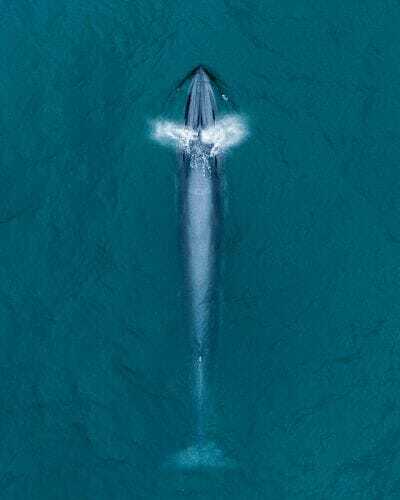
Over the years, the coast of Orange County has seen several rare cetacean species visiting its waters. Sei whales, pronounced ‘say,’ and Bryde’s whales, pronounces ‘broodus,’ are close cousins of the local fin whales. Sei whales can grow to lengths of 50-60 feet with Bryde’s whales just behind at 40-55 feet long. Bryde’s whale and Sei whales are similar in appearance but can be identified by the ridges on top of their rostrum – Bryde’s whales have one ridge while Sei whales have three. Bryde’s whales prefer warmer waters and only come to Orange County when warm ocean currents come through the area, like during El Niño events. Sei whales are found all over the world’s oceans, except for polar regions, though their behavior is unpredictable, and they sometimes disappear from areas for decades before returning. Both large whales belong to the baleen whale category and feed primarily on krill and small schooling fish.
Sperm whales
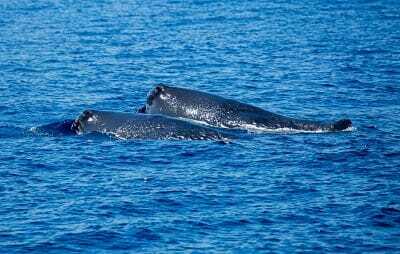
One of the most impressive animals on earth, sperm whales are a very rare visitor to Orange County, only being spotted approximately once every ten years. The largest member of the toothed whale family, sperm whales reach maximum lengths of 60 feet. Sperm whales are deep diving machines and have many adaptations to survive up to 3000 feet below the surface. They are considered breath-hold champions and can stay submerged under the surface for over two hours! To avoid the bends, they collapse their ribcage around their lungs and instead store oxygen in their blood and muscle tissue. Sperm whale’s use sophisticated echolocation to navigate and hunt in the pitch-black depths and can generate the loudest biological noise on the planet – their clicks can be 230 decibels. Their echolocation is produced in their giant square-shaped head (nearly 1/3 of their overall body length). Their head contains an oily substance called spermaceti, which sperm whales were hunted for throughout the 1800s- the early 20th century. Sperm whales are only found in water depths of greater than 1000 feet, where they dive to hunt giant squid. They can unexpectedly show up off Orange County at any time!
Killer whales
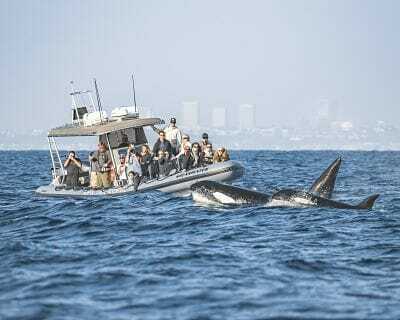
The iconic killer whale, or orca, is an infrequent visitor to Orange County. With no definite season and only 1-2 yearly sightings, each encounter with killer whales is extremely exciting! Belonging to the toothed whale category, they are actually the largest member of the dolphin family. Reaching lengths up to 25 feet, they are famous for their striking black and white coloration and tall black dorsal fins. They are one of the most social and intelligent animals on the planet and are the apex predators of the ocean. With ten distinct ecotypes found around the world, different pods feed on different prey. Some orcas are known to eat other marine mammals such as seals, sea lions, dolphins, and sometimes even other whales. Other orcas feed exclusively on fish, while others hunt sharks and sting rays. The pod that visits Orange County are called the Eastern Tropical Pacific orcas and are transients, or mammal-eaters. In the past they have been witnessed hunting our local common dolphins.
False killer whales
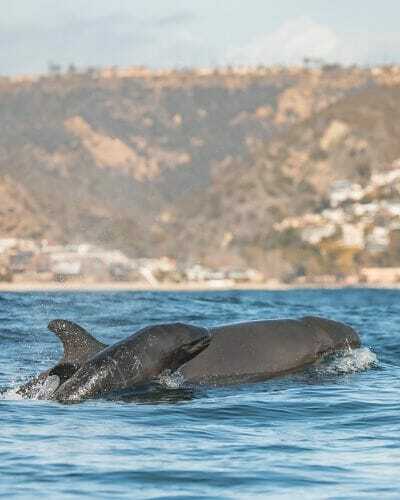
Unlike their name implies, false killer whales bear little physical resemblance to killer whales. Instead, they were given the name due to the similarities of their skull shape to that of a killer whale. False killer whale are the third largest dolphin species around the world at a maximum length of 15-20 feet. They are highly social and have been seen interacting with other dolphin species including bottlenose dolphins. False killer whales are deep divers, reaching depths of over 3000 feet. They feed primarily on squid and fish. False killer whales are typically spotted off the coast of Orange County approximately once a year and spring seems to have the best chances of seeing these rare visitors.
Pilot whales
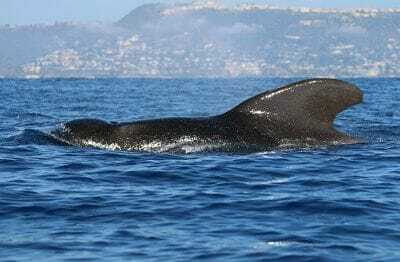
One of our most rare sightings, pilot whales can go almost two decades before returning to Orange County. A highly social species, pilot whales are the second largest species of dolphin just behind killer whales. Fully grown they reach lengths of 20 feet and often stay together with their birth pod for their entire lives. Feeding primarily on squid, pilot whales will also eat large species of fish such as cod. They are dark gray in color with narrow backswept flippers, a round, bulbous forehead, and a large sickle shaped dorsal fin on their back. Every pilot whale encounter is a treat!
For a chance to experience these animals in their natural habitat, Newport Landing and Davey’s Locker Whale Watching located in Newport Beach, CA offers fun, safe, and educational cruises daily with multiple departure times from 8am-6pm.
Frequently Asked Questions
What time of day are whales most active?
Whales are most active during twilight hours which are both before sunrise and after sunset.
Is whale vomit worth money?
Sperm whale vomit or ambergris, as it’s called, is so valuable it is referred to as floating gold. It is also illegal to collect, keep or sell in the U.S.
How do whales sleep?
Whales either rest quietly in the water, vertically or horizontally, or sleep while swimming slowly next to another animal, similar to napping.
Why do Whales breach?
Whales breach for many reasons including to aid in degestion, to remove parasites, to communicate a desire or a need, to warn of predators and just for fun.
Why are orcas called killer whales?
They are call killer whales because they prey on larger whale species. Orca is another word for killer whale and come Latin name, Orcinus orca.
Is an orca a dolphin?
Yes, orcas are the largest species in the dolphin family.
Related Articles
| Best Tidepools In Orange County | Scuba Diving & Snorkeling Spots |
| Shark Sightings And Attacks | Best Beaches In Orange County |
| Best OC Surf Spots | Whale Watching In OC |
Author: Erica Page, Marine Science Educator, Newport Landing Whale Watching
